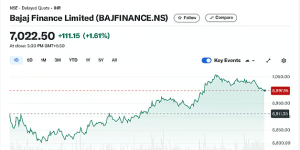
Bajaj Finance Limited, a subsidiary of Bajaj Finserv, is one of India’s leading non-banking financial companies (NBFCs). Over the years, it has gained immense investor trust and has become a key stock in the Indian financial market. The Bajaj Finance share price is often a topic of interest among retail and institutional investors, thanks to its consistent performance, strong fundamentals, and growth potential.
In this comprehensive guide, we will explore the historical performance, current trends, factors affecting the share price, and the future outlook of Bajaj Finance stock. Whether you’re a long-term investor or a short-term trader, this article offers insights that can help guide your investment decisions.
Overview of Bajaj Finance
Founded in 1987, Bajaj Finance is headquartered in Pune, Maharashtra. The company offers a wide range of financial services, including:
- Consumer lending
- SME finance
- Commercial lending
- Rural lending
- Fixed deposits
- Wealth management
Bajaj Finance operates through a wide network of branches and digital platforms, making it accessible to millions of customers across India. It is also listed on both the Bombay Stock Exchange (BSE) and the National Stock Exchange (NSE).
Historical Share Price Performance
The Bajaj Finance share price has shown exceptional growth over the past decade. From being a relatively low-profile NBFC, it has transformed into a market leader, delivering impressive returns to shareholders.
- 2010-2015: During this period, the stock witnessed steady growth due to the rising demand for consumer and personal loans. The management’s focus on technology and risk management further boosted investor confidence.
- 2016-2020: Bajaj Finance became one of the most popular stocks among investors. With the rise of digital lending, its aggressive customer acquisition strategy paid off well. The share price increased multiple folds, outperforming major indices like the Nifty 50 and Sensex.
- 2020-2021 (COVID-19 Impact): Like all financial stocks, Bajaj Finance saw a sharp decline in early 2020 due to fears around loan defaults. However, it quickly recovered thanks to its strong asset quality and agile business model.
- 2022-Present: Bajaj Finance continues to remain a top performer, driven by solid quarterly results, increased digitization, and growing consumer demand.
Current Share Price Trends (As of May 2025)
As of early May 2025, the Bajaj Finance share price is trading in the range of ₹6,500 to ₹7,000 per share. The stock has been showing moderate volatility in recent months, which is typical for financial services companies in a changing interest rate environment.
Some current market observations include:
- Steady quarterly earnings with increasing net profit
- Rise in new customer acquisition
- Healthy loan book growth
- Improved asset quality, with NPAs under control
These factors have led to a renewed interest from both retail and institutional investors.
Key Factors Influencing Bajaj Finance Share Price
Several internal and external factors can affect the movement of Bajaj Finance’s stock price. Here are the major ones:
1. Financial Performance
Investors closely watch Bajaj Finance’s quarterly results. Metrics such as net interest income (NII), net profit, return on equity (ROE), and non-performing assets (NPAs) heavily influence its share price.
2. Interest Rates
As an NBFC, Bajaj Finance is sensitive to changes in interest rates. A hike in interest rates can increase borrowing costs, while a cut can boost lending margins.
3. Regulatory Changes
Changes in RBI guidelines, NBFC regulations, or government policies can have an impact on the company’s operations and profitability.
4. Digital Transformation
Bajaj Finance has invested significantly in digital infrastructure. Positive updates regarding technology adoption and digital customer onboarding can push the share price higher.
5. Market Sentiment
Like all stocks, market sentiment and global economic indicators also play a role. A positive sentiment toward the Indian economy or financial sector generally bodes well for Bajaj Finance.
Shareholding Pattern
Understanding the shareholding pattern can provide insights into investor confidence:
- Promoters: Around 56%
- Foreign Institutional Investors (FIIs): Approx. 21%
- Mutual Funds & Insurance Companies: Approx. 12%
- Retail & Others: Around 11%
The significant FII and mutual fund holdings reflect institutional trust in the company’s long-term growth.
Bajaj Finance vs. Competitors
Bajaj Finance competes with other NBFCs and financial institutions like:
- HDFC Ltd (now merged with HDFC Bank)
- LIC Housing Finance
- Muthoot Finance
- Mahindra Finance
Despite stiff competition, Bajaj Finance has carved out a unique position due to its superior underwriting model, diversified loan portfolio, and customer-centric approach.
Expert Opinions and Analyst Ratings
Most brokerage firms and financial analysts maintain a “Buy” or “Hold” rating on Bajaj Finance. The stock is often viewed as a solid long-term investment due to:
- Strong fundamentals
- Expanding customer base
- Robust risk management
- Digital-first approach
Leading brokerages like Motilal Oswal, ICICI Securities, and Axis Direct have set target prices ranging from ₹7,500 to ₹8,000 for the next 12-18 months, assuming stable macroeconomic conditions.
Future Outlook
The future looks promising for Bajaj Finance, supported by:
- India’s rising middle class and consumer spending
- Increase in credit penetration, especially in rural areas
- Continued digital innovation
- Diversification into wealth management and insurance
If the company continues to maintain its asset quality and innovation pace, the Bajaj Finance share price could see significant appreciation in the next few years.
However, investors should also watch for:
- Any adverse changes in RBI policy
- Global economic uncertainties
- Potential increase in credit risk
Conclusion
The Bajaj Finance share price is a reflection of the company’s consistent growth, robust risk management, and strategic foresight. While it has experienced periods of volatility like any other stock, the long-term trajectory remains upward. For investors seeking exposure to India’s growing financial services sector, Bajaj Finance remains a strong contender.
Whether you’re a short-term trader looking for momentum or a long-term investor seeking quality stocks, monitoring Bajaj Finance can be a wise decision. Always consider your investment goals and risk tolerance before making any stock purchase.